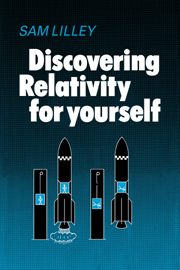Book contents
- Frontmatter
- Contents
- Preface
- Introduction
- 1 Getting started
- 2 Rough and ready Relativity
- 3 The dilation of time
- 4 Three clocks and a pair of twins
- 5 Starting again
- 6 Space–time diagrams
- 7 Time and distance ‘over there’
- 8 Co-ordinate systems
- 9 Combining speeds
- 10 Causality and the speed of light
- 11 The nature of spacetime
- 12 Interval
- 13 Old friends revisited
- 14 The scales of the spacetime diagram
- 15 The radar point of view
- 16 Relations between the radar and time–distance systems
- 17 Constant acceleration
- 18 Dynamics–mass, momentum, force
- 19 The mass–energy relation
- 20 The effect of acceleration on time measurement
- 21 Time as experienced by a constant acceleration traveller
- 22 Time and distance measurements of a constant acceleration observer
- 23 The Principle of Equivalence
- 24 The metric
- 25 Introducing geodesies
- 26 How to find ordinary geodesies
- 27 Inverse square law gravity
- 28 Curved spacetime
- 29 The metric around the Sun
- 30 Light and gravity
- 31 The scandal about Mercury
- 32 How Einstein did it
- 33 A few conclusions
- Index
- Frontmatter
- Contents
- Preface
- Introduction
- 1 Getting started
- 2 Rough and ready Relativity
- 3 The dilation of time
- 4 Three clocks and a pair of twins
- 5 Starting again
- 6 Space–time diagrams
- 7 Time and distance ‘over there’
- 8 Co-ordinate systems
- 9 Combining speeds
- 10 Causality and the speed of light
- 11 The nature of spacetime
- 12 Interval
- 13 Old friends revisited
- 14 The scales of the spacetime diagram
- 15 The radar point of view
- 16 Relations between the radar and time–distance systems
- 17 Constant acceleration
- 18 Dynamics–mass, momentum, force
- 19 The mass–energy relation
- 20 The effect of acceleration on time measurement
- 21 Time as experienced by a constant acceleration traveller
- 22 Time and distance measurements of a constant acceleration observer
- 23 The Principle of Equivalence
- 24 The metric
- 25 Introducing geodesies
- 26 How to find ordinary geodesies
- 27 Inverse square law gravity
- 28 Curved spacetime
- 29 The metric around the Sun
- 30 Light and gravity
- 31 The scandal about Mercury
- 32 How Einstein did it
- 33 A few conclusions
- Index
Summary
In the region around the Sun there's only one other test to which we can subject our theory–we can ask how well it does in predicting the motion of a planet. Newtonian theory says that the orbit is an ellipse, and observation over the centuries has confirmed that this must be very near the truth. So we shall have to study some properties of ellipses.
If you're already well up in the subject, you may find it good enough to (1) note the definitions of the quantities, as summarised in Figure 31.2; (2) check that (31.7) is an old friend, lightly disguised by writing x/r instead of cos φ (3) check that you know how to derive (31.12) from (31.7), and that you understand its significance; (4) check (as in §31.12 or by geometry) that the extreme values of r are given by (31.17); and (5) make sure you are familiar with (31.22) as a way of putting δ (sin φ) ∼ cos φδφ.
You probably know a practical recipe for drawing an ellipse. The ends of a piece of string are fixed to two pins stuck in a sheet of paper; if a pencil point (always in contact with the paper) is moved so that it keeps the string constantly taut, then it will draw an ellipse. To formalise that a little, we confine ourselves to a plane in which we have chosen two points S and S' (replacing the pins).
- Type
- Chapter
- Information
- Discovering Relativity for Yourself , pp. 372 - 393Publisher: Cambridge University PressPrint publication year: 1981



